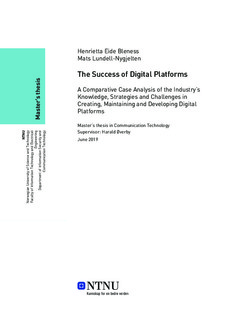| dc.contributor.advisor | Øverby, Harald | |
| dc.contributor.author | Bleness, Henrietta Eide | |
| dc.contributor.author | Lundell-Nygjelten, Mats | |
| dc.date.accessioned | 2020-02-28T15:00:35Z | |
| dc.date.available | 2020-02-28T15:00:35Z | |
| dc.date.issued | 2019 | |
| dc.identifier.uri | http://hdl.handle.net/11250/2644475 | |
| dc.description.abstract | Behovet for å gjennomføre transaksjoner med andre mennesker har alltid vært en essensiell del av menneskets historie. Fra tidenes morgen har mennesker møttes ved markedsplasser for å handle varer, eller funnet sin partner ved hjelp av en profesjonell Kirsten Giftekniv. I nyere tid, har utvikling av trykkpressen gjort avisene om til en plattform, som tilrettelegger for kommunikasjon gjennom rubrikkannonsene. Ved at Internett ble mer brukt i det daglige, har tjenester som dette blitt digitalisert. Rubrikkannonser har blitt lett tilgjengelige på nett, og det har utfoldet seg mange lignende plattformer. Man kan gjennom tidene skimte stegene av utviklingen til plattformer, men det er vanskelig å se de åpenbare grunnene til hvorfor de ble etablert. Tidligere forskning har sett på innvirkningene nettverkseffekter har hatt på suksessen til digitale plattformer. Bedrifter som har klart å utnyttet disse nettverkseffektene har utviklet seg til å bli noen av de mest lønnsomme bedriftene som finnes i dag.
Denne masteroppgaven gjennomfører en komparativ studie av forskjellige typer plattformer, og består av tre deler. Vi vil først se på de forskjellige grunnene for at bedrifter utvikler egne plattformer. Neste steg er å undersøke de strategiske og teknologiske insentivene og utfordringene for videre vekst, og se om de korrelerer med grunnene til å starte utviklingen av egen plattform. Siste del, del tre, fastslår de teknologiske begrensningene for videre utvikling av egen plattform. Vår komparative studie består av fem bedrifter (Facebook, FINN, Schlumberger, Vipps og Helse Midt-Norge (HMN)). De fleste av disse bedriftene er godt etablerte plattformbedrifter, og en er i ferd med å anskaffelse en plattform. Metodene brukt i denne oppgaven er litteraturstudie og semistrukturerte intervjuer. Funnene fra intervjuene har blitt konkretisert ved hjelp av empirisk koding og kategorisering. Kategoriseringen har blitt utført av forfatterne for å gi en mer presis diskusjon, og bedre anbefalinger for utvikling av digitale plattformer.
Hovedfunnene viser at før man starter å utvikle en plattform burde bedriften ha et etablert og suksessfullt produkt plattformen kan utvikles rundt. Interessante funn viser at det teknologiske aspektet ikke er en like stor begrensning for en sunn plattformutvikling som de strategiske valgene. Vi fant ønsket om full kontroll til å være den største hindringen. Dette ønsket hindrer plattformeiere i å utvikle den plattformen de i utgangspunktet ønsket seg. Basert på analysen av hver bedrift og den eksisterende litteraturen, har vi konkludert med generaliserte anbefalinger for plattformutvikling. I tillegg, gir konklusjonen en liten prediksjon av hva den potensielle fremtidige digitale plattformen kan være. | |
| dc.description.abstract | The desire to transact with people has always been an essential part of human history. From early ages, people met at marketplaces to trade goods or was matched with a spouse by professional matchmakers. In more recent years, the development of the printing press made newspapers a matchmaker between people through classifieds ads. Services such as these were digitized as the Internet has normalized digital communication and application for everyday use. Classified ads have become easily available online, and the Internet flourishes with these types of platforms. Even though we can see the path of evolution for platforms throughout time, the reason to create one is not always clear. This research done on the concept of digital platforms has looked into the impact network effects has on the success of a platform. Companies which utilizes the power of network effects have risen to become the most profitable companies of today.
This thesis conducts a comparative case analysis of different types of platforms and consists of three parts. We will first, in part one, investigate the rationales companies have to develop their platform. Secondly, in part two, look into the strategic and technological motivations and challenges for further growth, and if they are correlated to the rationales to develop a platform. Lastly, in part three, determine the technological limitations for platform growth. The case analysis consists of five companies (Facebook, FINN, \Gls{CNRHA}, Schlumberger, and Vipps). Most of them have a dominant part of their industry as platform companies, and one is acquiring a platform. The methods used in this thesis are a literature review and semi-structured interviews. The findings from the interviews have been narrowed down by empirical close coding and categorization. The categories have been proposed by the authors to give a more precise discussion and better recommendations on the topic.
The main findings show that the rationale to develop a platform around an already established product is essential. Interesting findings show that the technology aspect is not the main limitation for healthy platform growth. We found the need for control to be the main limitation, preventing companies from developing the platform they initially wanted to create. Based on the analysis of each company and the existing literature search, we conclude with generalized recommendations for platform development and evolution. Also, the conclusion gives a small prediction of the future digital platform. | |
| dc.language | eng | |
| dc.publisher | NTNU | |
| dc.title | The Success of Digital Platforms: A Comparative Case Analysis of the Industry’s Knowledge, Strategies and Challenges in Creating, Maintaining and Developing Digital Platforms | |
| dc.type | Master thesis | |
